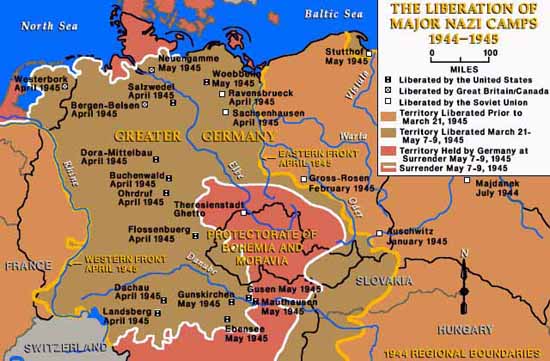Allied Liberators: Background & Overview
As the Allies approached, some of the concentration camps were dismantled, and the prisoners were taken on forced marches for miles in the cold and snow. Many were so weak from their time in the camp that they died on the road. Those who fell or were too slow were usually shot.
The images most people have of the Holocaust are those from the pictures taken after liberation: the emaciated bodies of the living, half-burned corpses, ashes in crematoria ovens, stacks of naked bodies, and mountains of hair, glasses, and shoes. Photographs, however, cannot capture the sounds of suffering or the smell of death.
The death camp Majdanek in Poland was the first to be liberated. Soviet soldiers entered the camp in the final stages of the war, on July 23, 1944. Few prisoners were found alive, but they did find 800,000 pairs of shoes. Shortly thereafter the Red Army overran several other killing centers. On January 27, 1945, they entered Auschwitz and there found hundreds of sick and exhausted prisoners. The Germans had been forced to leave these prisoners behind in their hasty retreat from the camp. Also left behind were victims' belongings: 348,820 men's suits, 836,255 women's coats, and tens of thousands of pairs of shoes
The Allies did not liberate their first camps until April 1945, when the British entered Bergen-Belsen and the Americans liberated Buchenwald and Dachau. Although the Germans had attempted to empty the camps of surviving prisoners and hide all evidence of their crimes, the Allied soldiers came upon thousands of dead bodies "stacked up like cordwood," according to one American soldier. The prisoners who were still alive were living skeletons. The headline of one Army journalist’s story may have expressed the liberators’ feelings best, “Dachau Gives Answer To Why We Fought.”
Even after the Allies arrived, many prisoners were beyond help. In Bergen-Belsen, for example, 300 former prisoners died each day for a week. Half of the prisoners discovered alive in Auschwitz died within a few days of being freed. Nearly 2,500 of the 33,000 survivors of Dachau died within six weeks of liberation. Disease, malnourishment, and mistreatment had worn them down too much.
After the camps were liberated, prisoners sometimes took justice into their own hands and turned on their guards. In a few instances, the liberators themselves were so horrified by what they saw that they summarily executed the Nazis they captured
Survivors had mixed reactions to their newfound freedom. While a few looked forward to being reunited with other family members, some felt guilty for surviving when so many of their relatives and friends had died. Some felt overwhelmed, as one survivor, Viktor Frankl, a psychiatrist, expressed: "Timidly, we looked around and glanced at each other questioningly. Then we ventured a few steps out of the camp. This time no orders were shouted at us, nor was there any need to duck quickly to avoid a blow or a kick. 'Freedom,' we repeated to ourselves, and yet we could not grasp it."
Sources: U.S. Holocaust Memorial Museum; Mitchell G. Bard, The Complete Idiot's Guide to World War II. NY: MacMillan, 1998.



